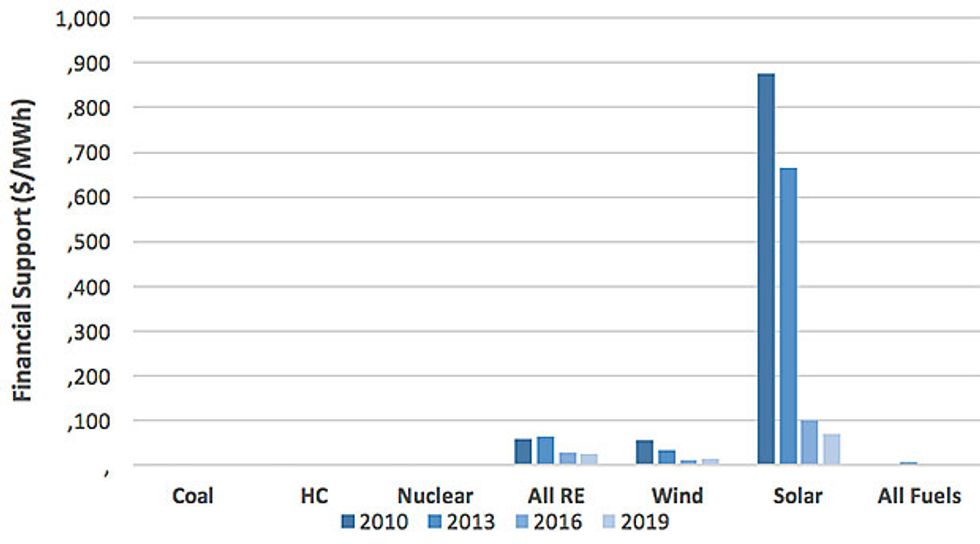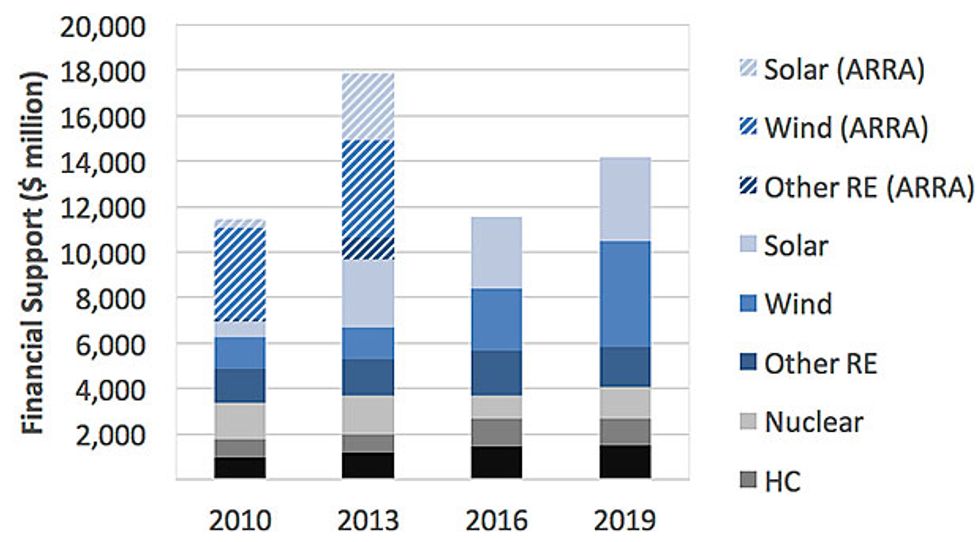Exactly what is a subsidy, who pays for them, and who benefits? Everybody in the energy business has an opinion but few people agree on any one answer. The American Petroleum Institute, an oil and gas trade association, offers a fact sheet arguing that their industry isn’t subsidized; the Nuclear Energy Institute offers an analysis that reaches contrary conclusions. Renewables either receive disproportionate largess or are underfunded, depending on whom you ask.
While these questions incite cross-talk, not cross-tabulation. But we elected to do the latter as part of a comprehensive, interdisciplinary research project called the Full Cost of Electricity (FCe-) conducted by the University of Texas at Austin Energy Institute. Our analysis of energy subsidies aims to estimate the magnitude of federal financial support offered to various electricity supply chains and technologies—gas turbines, nuclear power plants, wind turbines—from mine-mouth to wall socket.
Over the period 2010 to 2019, we identified 76 programs worth US $11 billion to $18 billion per year that met our criteria for intentionality, selectivity/preferentiality, and the potential for wealth transfer. Bottom line? In total dollars, the fossil fuel industry receives benefits comparable to that for the renewables industry, but when considering only the portion of fossil fuel support that relates to electric power, renewables receive far more support.
Different technologies benefit from different kinds of financial support, a complex arrangement that lends itself to calculations that tell only part of the story. Renewable generation is supported by direct subsidies (money for electricity) while generation from fossil fuels is supported via indirect subsidies (tax preferences on fuel production). Some would argue that subsidies need to be narrowly defined as transactional, à la money for electricity. We disagree.
Both types of subsidies reduce costs for generators—albeit in different ways. Renewables-focused subsidies like the Production Tax Credit and the Investment Tax Credit offer clear benefit to wind and solar. But tax preferences for the oil and gas industry can also alter the economics of electricity generation—for example, making fuel for natural gas power plants less expensive than it would be otherwise. Importantly, the complex nature of energy consumption means that some subsidies support electricity generators as well as transportation, home heating, and petrochemicals.
While subsidies spending on conventional technologies and renewables is commensurate today, renewables spending is forecast to accelerate. Ongoing spending for renewables is forecast to rise from $3.5 billion in 2010 to more than $10 billion in 2019. “Shovel ready” jobs and one-off rebate programs provided as part of the American Recovery and Reinvestment Act of 2009 (an Obama era stimulus bill) added billions more in temporary funding.
On an energy basis, wind and solar receive orders of magnitude more support than their conventionally fueled brethren (see chart below). Depending on the year, conventional technologies receive less than $2 per megawatt-hour. By contrast, wind received $57/MWh in 2010, falling to $15/MWh over our study period. Astonishingly, solar support stood at $876/MWh in 2010 but is expected to decline to $70/MWh by 2019.
All in, electricity technologies receive financial support worth $3–5/MWh. That works out to $30 to $60 per capita. The reason we estimate such relatively high financial support for wind and solar on a megawatt-hour basis (and that declines rapidly over time) is that we divide annual spending by annual generation for each fuel and technology as an “industry,” that is, not lifetime spending on a project divided by lifetime megawatt-hours from a project.

The figures for total support and support-per megawatt-hour tell very different stories. That’s the point. At the end of the day, you get what you measure, and in the case of energy subsidies, what you measure varies a lot.
Our hope isn’t to tell people what measurement is best, or what subsidies are good or bad. As with our white paper and journal article that provide a fresh take on levelized cost of electricity (LCOE), our goal is to provide a standardized benchmark to compare subsidies across the energy space as they relate to electricity.
For details of inclusion criteria, evaluation methods, and calculations, read the complete white paper “Federal Financial Support for Electricity Generation Technologies” [PDF], prepared by the University of Texas Austin Energy Institute.
Carey W. King is the assistant director and a research scientist at the University of Texas at Austin Energy Institute. Ben Griffiths is a student researcher in Energy and Earth Resources at the Jackson School of Geosciences, University of Texas.





